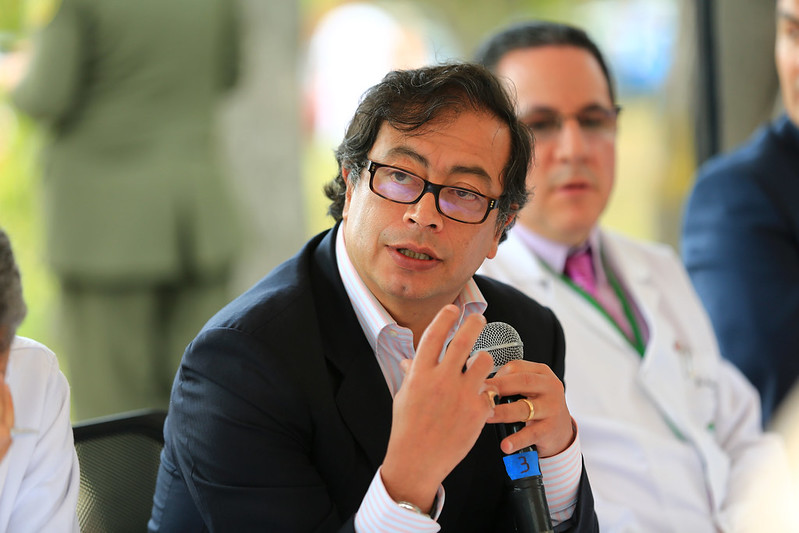The Politics Of Disaster Relief
After a 7.0 magnitude earthquake struck Haiti, the aftershock reached China in ways that few anticipated.The earthquake forced Chinese leaders to navigate the tricky politics of disaster relief.
This post is also available in: Español
This publication is part of Asia-LAC Dialogues, a series of interviews produced by the Inter-American Dialogue's Asia and Latin America Program, featuring global perspectives on recent developments in the Asia-Latin America and Caribbean dynamic.
Although China's relationship with Colombia is not among the most expansive of its bilateral relations within the LAC region, economic engagement between the two countries has nevertheless grown at a rapid pace in recent years. In 2006, Colombia exported only $454.6 million worth of goods to China and imported $2.01 billion from China. However, by 2021, China moved from Colombia’s 37th largest trading partner to its second, trailing only the United States. Moreover, Colombia exported $3.34 billion in goods to China and imported $9.95 billion of goods on average from 2011-2020. Coal and oil two accounted for $3 billion (or 82 percent) of total Colombian exports to China in 2021.
Chinese investments a have also grown a considerable rate, with major Chinese companies, such as China Harbour Engineering Company Limited and BYD, having established now-solid footing, after sometimes tenuous initial forays into the country. To date, Chinese companies have demonstrated growing interest, often through public-private partnerships, in Colombia’s infrastructure, telecommunications, and energy sectors. One example is the Bogotá metro project, which was awarded to a consortium of Chinese companies that includes China Harbour Engineering Company Limited and Xi’An Metro Company Limited, and which is valued at about $12 billion. In recent years, Colombia also received loans from Chinese commercial banks for two highway projects, according to the Inter-American Dialogue's China-Latin America Commercial Loans Tracker.
The June 2022 election of Gustavo Petro to Colombia's presidency has led many to anticipate some growth in the scale of Sino-Colombian relations in the coming months and years. Indeed, last week's visit to Colombia by US Secretary of State Antony Blinken sought to underscore enduring political and economic ties between the US and Colombia at a moment when China's role in Colombia is expected to grow to some degree.
An initial indication of stronger ties would be a Colombian government decision to sign on to the Belt and Road Initiative (BRI). That said, even Petro's predecessor, Ivan Duque, though strongly supportive of US-Colombia ties, reportedly considered joining the BRI during a 2019 visit to Beijing. As it stands, Colombia is one of only 12 remaining LAC countries, including Taiwan's eight remaining allies in the region, that have yet to sign on to the initiative.
For additional insight on prospects for future China-Colombia relations, we spoke with David Castrillón-Kerrigan, research professor at the Universidad Externado de Colombia’s School of Finance, Government, and International Relations about his perspectives on Colombia’s evolving relationship with China.
Inter-American Dialogue: How is Colombian President Gustavo Petro expected to engage with China during these next few months and years? What areas have been identified for deeper cooperation? Are there impediments to enhanced Colombia-China relations?
[caption id="attachment_129544" align="alignleft" width="400"] David Castrillón-Kerrigan is a research professor at the School of Finance, Government, and International Relations of Universidad Externado de Colombia.[/caption]
David Castrillón-Kerrigan is a research professor at the School of Finance, Government, and International Relations of Universidad Externado de Colombia.[/caption]
Castrillón-Kerrigan: As a candidate and now as president, Petro has signaled that while relations with China will not be a priority during his term, they will be deepened and widened, following the path set by previous administrations.
On trade, investment, and contracts, relations are expected to continue on a positive path, with China gaining on or now surpassing Western countries, particularly the US. Trade data over the past two decades demonstrates this trend. While the US represented 38.1 percent of all Colombian imports and exports of goods in 2002, by 2021 the US had dropped to 24.8 percent. Meanwhile, the Chinese share grew from 2 percent to 17.1 percent. This trend is likely to continue as the Chinese government stresses domestic consumption and as new bilateral phytosanitary agreements are put into place for the entry of a more diverse basket of Colombian agricultural products to the Chinese market.
These four years will also see Chinese companies deliver or continue work on major infrastructure projects: the Mar-2 highway, for which work began only in 2018, will be completed in the coming months; the Regiotram light rail system is scheduled to be completed by 2026; and the first line of the Bogota Metro will be a year away from completion by the next elections. Several other projects are in the pipeline. Whether the companies deliver on their promises and meet the expectations of Colombians will greatly influence perception of China in the country and government.
Beyond the now well-cemented economic relationship, we foresee the Petro policy agenda and China to align in three key areas. One, on the response to the climate crisis, China is in a good position to work with Colombian government on projects related to energy transition and climate resilience. Two, on peace, as the country works in dialogues with various armed groups, the Chinese side has shown interest in significantly increasing assistance to newly expanded peace cooperation funds. Three, on regional development, targeted Chinese expertise and money might do much to bridge regional and rural-urban gaps.
As rosy as the future looks, bumps are also to be expected. For example, on the issue of ending the war on drugs, China will be an obstacle to any global consensus on the matter. There may also be tensions between the two sides as Chinese projects in the country come up against local opposition or environmental irregularities.
Inter-American Dialogue: What is the likelihood that Colombia joins the Belt and Road Initiative (BRI), Chinese president Xi Jinping’s signature foreign policy initiative?
Castrillón-Kerrigan: Since the previous administration, high officials on both sides have given strong and clear statements on Colombia’s intent to join the BRI. In March 2020, the then Colombian vice-foreign minister, Francisco Echeverri (a career diplomat), and the Chinese ambassador to Colombia, Lan Hu, declared in separate interviews that a deal would be signed within that year. In a July 2021 interview, the former Colombian ambassador to China, Luis Diego Monsalve, clarified that Colombia was “very close” to joining BRI, but that the pace of adhesion had slowed due to the pandemic. More recently, in May 2022, Monsalve once again said that all necessary documents were in place, but it would be up to the incoming Petro administration to make the decision.
So, will Colombia join? The likelihood of this happening is high. The promise of greater market access to China is a strong incentive. So is access to financing at a time when international capital markets are shying away from developing markets.
But both sides are likely to wait until the right moment to mark Colombia’s entry. There has never been a state visit to Colombia by a sitting Chinese president. Should President Xi Jinping choose to tour Latin America and stop by Colombia, conditions may be just right for that to happen.
Inter-American Dialogue: As China grapples with its own domestic economic challenges, what can Colombia reasonably expect from China, including beyond Petro’s term in office?
Castrillón-Kerrigan: China is in the midst of a necessary but complex transition to a new model of development that should make its economy more sustainable, innovative, and equitable. The transition is also meant to address many of the imbalances of the previous model that continue to rear their head today, for example, in terms of excess supply, narrow financial markets, and overreliance on investment for growth.
The changes to China’s model present opportunities and challenges to countries like Colombia. Three major opportunities come to mind. First, a more prosperous China focused on boosting domestic consumption and reducing reliance on developed markets will not only demand more from countries like Colombia, but it will gradually shift the type of demand from commodities to consumer goods and services. Second, a more innovative China is better positioned to shift certain aspects of production to Latin American countries for export; it can also work with them as laboratories for the adaptation and adoption of new technologies and standards. Third, a greener China can work with countries like Colombia in low-impact infrastructure projects, including in the energy sector. If the Petro administration takes advantage of these opportunities, their impact will be deeply felt in the Colombian economic structure and social fabric.
But the transition will not be without difficulties. For instance, gradual reductions in Chinese demand for certain mineral products and metals will affect exports from the region and prices. Much will depend on the capacity of governments, like that led by Petro, to adapt and respond to new conditions.
After a 7.0 magnitude earthquake struck Haiti, the aftershock reached China in ways that few anticipated.The earthquake forced Chinese leaders to navigate the tricky politics of disaster relief.
Despite reports in recent months that Mexican manufacturing is experiencing a resurgence, Mexico’s industrial sector faces tremendous challenges.
With no time to lose, Colombia’s newly appointed Director of National Planning has gotten to work on an ambitious agenda.
 Flickr | CC-BY-NC-2.0
Flickr | CC-BY-NC-2.0
 Video
Video